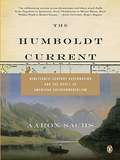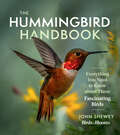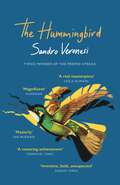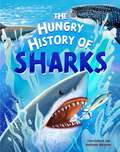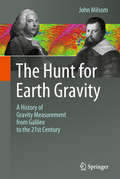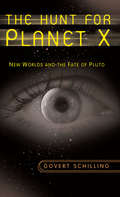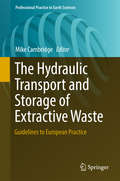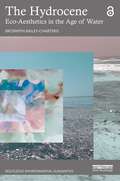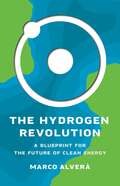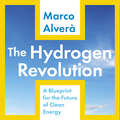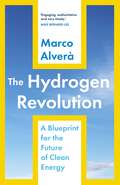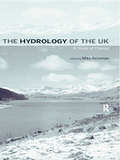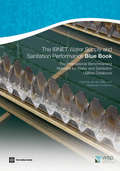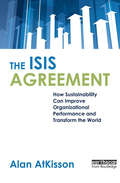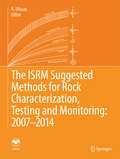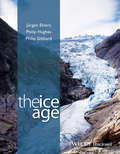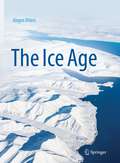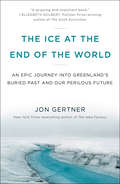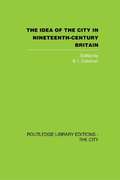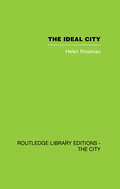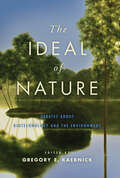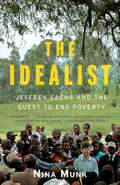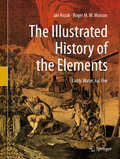- Table View
- List View
The Humboldt Current
by Aaron SachsWhile everyone has heard of the 'Humboldt Current', few know anything of the man after whom it was named. Yet Alexander von Humboldt was a towering figure of his time - scientist, explorer, and polymath, imbued with Enlightenment ideas - and he left a profound impact on the intellectual life of 19th century America. Aaron Sachs' colourful intellectual history rescues Humboldt from obscurity, and reveals the impact of a single European on both American thought and the environmental movement. Aaron Sachs traces Humboldt's legacy by focusing not only on the man himself but on the lives of other remarkable individuals who took their lead from him - explorers of the American mid-West, alienated Romantics, seminal American writers and artists, who together laid the groundwork for the great ecological tradition in 19th century America.
The Hummingbird Handbook: Everything You Need to Know about These Fascinating Birds
by John SheweyEverything you need to know about these fascinating birds Hummingbirds inspire an unmistakable sense of devotion and awe among bird lovers. Gardeners, too, love the company of hummingbirds, not only for their beauty, but also for their role as pollinators. Brimming with astonishing facts, practical advice, and important ecological information, The Hummingbird Handbook is a must-have guide to attracting, understanding, and protecting hummingbirds. From advice on feeders to planting and landscaping techniques that will have your garden whirring with tiny wings, lifelong birder John Shewey provides all you need to know to entice these delightful creatures. An identification guide makes them easy to spot in the wild, with stunning photographs, details on plumage variations, and range maps showing habitats and migration patterns. Need more joy in your life? Let this guide and nature&’s aerial jewels help you create a lively haven.
The Hummingbird: ‘Magnificent’ (Guardian)
by Sandro VeronesiA BOOK OF THE YEAR FOR THE GUARDIAN: 'DEEPLY PLEASURABLE'A BOOK OF THE YEAR FOR THE SPECTATOR: 'WHAT A JOY''Magnificent' Guardian'A towering achivement' Financial Times'Inventive, bold, unexpected' Sunday Times'Everything that makes the novel worthwhile and engaging is here: warmth, wit, intelligence, love, death, high seriousness, low comedy, philosophy, subtle personal relationships and the complex interior life of human beings'Guardian'Not since William Boyd's Any Human Heart has a novel captured the feast and famine nature of a single life with such invention and tenderness'Financial Times'There is a pleasing sense of having grappled with the real stuff of life: loss, grief, love, desire, pain, uncertainty, confusion, joy, despair - all while having fun'The Sunday Times'Instantly immersive, playfully inventive, effortlessly wise'Observer'Masterly: a cabinet of curiosities and delights, packed with small wonders'Ian McEwan'A real masterpiece. A funny, touching, profound book that made me cry like a little girl on the last page'Leïla Slimani'A remarkable accomplishment, a true gift to the world'Michael Cunningham'Ardent, gripping, and inventive to the core'Jhumpa LahiriMarco Carrera is 'the hummingbird,' a man with the almost supernatural ability to stay still as the world around him continues to change.As he navigates the challenges of life - confronting the death of his sister and the absence of his brother; taking care of his parents as they approach the end of their lives; raising his granddaughter when her mother, Marco's own child, can no longer be there for her; coming to terms with his love for the enigmatic Luisa - Marco Carrera comes to represent the quiet heroism that pervades so much of our everyday existence.A thrilling novel about the need to look to the future with hope and live with intensity to the very end.THE NO. 1 INTERNATIONAL BESTSELLEROver 300,000 copies soldSoon to be a major motion pictureWinner of the Premio StregaWinner of the Prix du Livre EtrangerBook of the Year for the Corriere della Sera
The Hungry History of Sharks (History of... #1)
by Clive GiffordThink all sharks are man-eating terrors? Think again! There's so much more to these fascinating and frequently misunderstood animals. This book takes you through the hungry history of these incredible creatures.Sharks range in size from whale sharks longer than buses, to Panama catsharks and dwarf lantern sharks that could sit across the palm of your hand. Find out about baby sharks, prehistoric sharks, the largest known shark - the Megaladon, bull sharks, reef sharks and angel sharks, amongst others. Look inside at the parts of a shark, such as their very light skeleton, their razor-sharp teeth and their extra special electric sense that humans don't have. Learn about their clever hunting and feeding techniques.How do we know so much about sharks? Discover how scientists are using many different technologies to find, follow and examine sharks to learn more about them. More than one-third of all shark and ray species are in danger of extinction. Learn what people are doing to help these formidable creatures.The colourful and detailed illustrations from Andressa Meissner bring the sharks vividly to life. The consultant, Leonardo Guida, (PhD) is a shark scientist and shark conservation lead at the Australian Marine Conservation Society.
The Hunt for Earth Gravity: A History of Gravity Measurement from Galileo to the 21st Century
by John MilsomThe author of this history of mankind’s increasingly successful attempts to understand, to measure and to map the Earth’s gravity field (commonly known as ‘little g’ or just ‘g’) has been following in the footsteps of the pioneers, intermittently and with a variety of objectives, for more than fifty years. It is a story that begins with Galileo’s early experiments with pendulums and falling bodies, progresses through the conflicts between Hooke and Newton and culminates in the measurements that are now being made from aircraft and satellites. The spectacular increases in accuracy that have been achieved during this period provide the context, but the main focus is on the people, many of whom were notable eccentrics. Also covered are the reasons WHY these people thought their measurements would be useful, with emphasis in the later chapters on the place of ‘g’ in today’s applied geology, and on the ways in which it is providing new and spectacular visions of our planet. It is also, in part, a personal memoir that explores the parallels between the way fieldwork is being done now and the difficulties that accompanied its execution in the past. Selected topics in the mathematics of ‘g’ are discussed in a series of short Codas.
The Hunt for Planet X
by Govert SchillingEver since the serendipitous discovery of planet Uranus in 1871, astronomers have been hunting for new worlds in the outer regions of our solar system. This exciting and ongoing quest culminated recently in the discovery of hundreds of ice dwarfs in the Kuiper belt, robbed Pluto from its 'planet' status, and led to a better understanding of the origin of the solar system. This timely book reads like a scientific 'who done it', going from the heights of discovery to the depths of disappointment in the hunt for 'Planet X'. Based on many personal interviews with astronomers, the well-known science writer Govert Schilling introduces the heroes in the race to be the first in finding another world, bigger than Pluto.
The Hurricane (Routledge Revivals)
by Roger A PielkeFirst published in 1990, this book describes the nature of the hurricane, one of the world's most dangerous weather hazards. It examines the formation, development, movement, and impact of these tropical cyclones, and assess the ability of science to describe, forecast, and control them.
The Hydraulic Transport and Storage of Extractive Waste
by Mike CambridgeThis book offers the guidelines on long-term confinement of fine particulate waste products in a safe and environmentally acceptable location. It seeks to present the state of the art, drawing on combined experience from within the European Union (EU), on good international practice where relevant and on lessons learnt from recent untoward incidents. These guidelines have been developed in parallel with the development of the European Standard on Earthworks (prEN 16907) and the contents have been influenced by the well-publicised need for guidance to all stakeholders on both technical and regulatory aspects of the permitting, design and construction of extractive waste facilities in Europe. The Extractive Waste Directive (EWD) imposes a duty on all operators and regulators to ensure the competent design, operation and closure of such facilities. However, though some guidance has been published on a limited number of related technical elements, the relevance of these contributions has been diminished by the lack of an integrated approach. It is now evident to both regulatory bodies and operators alike that a unified and comprehensive document providing guidance to all stakeholders is required if the future of mining within the EU is to be assured and further untoward incidents avoided. These guidelines seek to address all technical stages of the development of a hydraulic fill project in the context of the EWD, with an emphasis on waste and facility characterisation and on the risk-based assessments which underwrite them. They are intended for use by all stakeholders involved in those European industries which involve the generation, transport and storage of fine particulate waste products requiring long-term confinement in a safe, stable and environmentally acceptable location.
The Hydrocene: Eco-Aesthetics in the Age of Water (ISSN)
by Bronwyn Bailey-CharterisThis book challenges conventional notions of the Anthropocene and champions the Hydrocene: the Age of Water. It presents the Hydrocene as a disruptive, conceptual epoch and curatorial theory, emphasising water's pivotal role in the climate crisis and contemporary art.The Hydrocene is a wet ontological shift in eco-aesthetics which redefines our approach to water, transcending anthropocentric, neo-colonial and environmentally destructive ways of relating to water. As the most fundamental of elements, water has become increasingly politicised, threatened and challenged by the climate crisis. In response, The Hydrocene articulates and embodies the distinctive ways contemporary artists relate and engage with water, offering valuable lessons towards climate action. Through five compelling case studies across swamp, river, ocean, fog and ice, this book binds feminist environmental humanities theories with the practices of eco-visionary artists. Focusing on Nordic and Oceanic water-based artworks, it demonstrates how art can disrupt established human–water dynamics. By engaging hydrofeminist, care-based and planetary thinking, The Hydrocene learns from the knowledge and agency of water itself within the tide of art going into the blue.The Hydrocene urgently highlights the transformative power of eco-visionary artists in reshaping human–water relations. At the confluence of contemporary art, curatorial theory, climate concerns and environmental humanities, this book is essential reading for researchers, curators, artists, students and those seeking to reconsider their connection with water and advocate for climate justice amid the ongoing natural-cultural water crisis.The Open Access version of this book, available at http://www.taylorfrancis.com, has been made available under a Creative Commons Attribution-Non Commercial-No Derivatives (CC-BY-NC-ND) 4.0 license.
The Hydrogen Revolution: A Blueprint for the Future of Clean Energy
by Marco AlveràAn energy expert shows why hydrogen can fight climate change and become the fuel of the future We&’re constantly told that our planet is in crisis; that to save it, we must stop traveling, stop eating meat, even stop having children. But in The Hydrogen Revolution, Marco Alverà argues that we don&’t need to upend our lives. We just need a new kind of fuel: hydrogen. From transportation and infrastructure to heating and electricity, hydrogen could eliminate fossil fuels, boost economic growth, and encourage global action on climate change. It could also solve the most bedeviling aspects of today&’s renewable energy—from transporting and storing wind and solar energy and their vulnerability to weather changes to the inefficiency and limited utility of heavy, short-lasting batteries. The Hydrogen Revolution isn&’t just a manifesto for a powerful new technology. It&’s a hopeful reminder that despite the gloomy headlines about the fate of our planet, there&’s still an opportunity to turn things around.
The Hydrogen Revolution: a blueprint for the future of clean energy
by Marco Alverà'Engaging, authoritative and very timely. Marco Alverà spells Hydrogen's critical role as an energy store in the clean power transition' - Mike Berners-Lee, author of THERE IS NO PLANET BPicture this: It's 2050. The looming shadow of climate change is finally receding. The planet's temperature is stabilising. Rainforests and coral reefs beginning to thrive once more. We are returning to equilibrium with nature. This isn't wishful thinking; it can be our reality. We just need to embrace hydrogen: the missing link.The beauty of hydrogen is its simplicity. It's simple to make, and simple to use. You are essentially bottling sunlight from renewable energy sources in the form of hydrogen, and using it to bring clean energy to every corner of the globe. The best part about hydrogen is that when you use it, the only by-product is water.As energy expert Marco Alverà explains, if we're going to heal the climate, we need to start thinking big. This book is the blueprint for how to get us there. Whether you are a policy maker, a business person, an activist, or simply curious, the message is this: there is hope, for us and our planet. Hydrogen can help save the world.(P) 2021 Hodder & Stoughton Limited
The Hydrogen Revolution: a blueprint for the future of clean energy
by Marco Alverà'Engaging, authoritative and very timely. Marco Alverà spells Hydrogen's critical role as an energy store in the clean power transition' - Mike Berners-Lee, author of THERE IS NO PLANET BPicture this: It's 2050. The looming shadow of climate change is finally receding. The planet's temperature is stabilising. Rainforests and coral reefs beginning to thrive once more. We are returning to equilibrium with nature. This isn't wishful thinking; it can be our reality. We just need to embrace hydrogen: the missing link.The beauty of hydrogen is its simplicity. It's simple to make, and simple to use. You are essentially bottling sunlight from renewable energy sources in the form of hydrogen, and using it to bring clean energy to every corner of the globe. The best part about hydrogen is that when you use it, the only by-product is water.As energy expert Marco Alverà explains, if we're going to heal the climate, we need to start thinking big. This book is the blueprint for how to get us there. Whether you are a policy maker, a business person, an activist, or simply curious, the message is this: there is hope, for us and our planet. Hydrogen can help save the world.
The Hydrology of the UK: A Study of Change (Routledge Environmental Management)
by Mike AcremanThe Hydrology of the UK assesses the changing hydrology of the UK, focusing on key issues that affect the fundamental hydrological processes and have important implications for water resource management, flood risk and environmental quality. The bookis divided into 3 sections: Section 1 examines the causes of change to the hydrology of the UK, including the impact of climate change, land use and geomorphological change, and dam construction. Section 2 assesses the effects of these pressures on UK rivers, goundwater, lakes, ponds, reservoirs and wetlands, looking at water quality, degradation, pollution and protection. Section 3 examines the responses of goverment organisations responsible for planning and management of water, including Environment Agencies, British Hydrological Society and the growing urgency for a World Hydrology Initiative.Change will continue to be a major feature of UK hydrology in the future. This book provides an understanding of the changing hydrology of the UK and the international scene today and looks to the needs for the future.
The Hyena Scientist (Scientists in the Field Series)
by Sy Montgomery Nic BishopThis myth-busting new addition to the critically acclaimed Scientists in the Field series by Sibert medal winning team Sy Montgomery and Nic Bishop is perfect for nonfiction readers looking for more female scientist narratives, or a fresh perspective on an underrepresented animal—Hyenas! Timely and inspiring, The Hyena Scientist sets the record straight about one of history’s most hated and misunderstood mammals, while featuring the groundbreaking, pioneering research of a female scientist in a predominately male field in this offering by Sibert-winning duo Sy Montgomery and Nic Bishop. As a scientist studying one of the only mammalian societies led entirely by females, zoologist Kay Holecamp has made it her life’s work to understand hyenas, the fascinating, complex creatures that are playful, social, and highly intelligent—almost nothing like the mangy monsters of pop culture lore.
The IBNET Water Supply and Sanitation Performance Blue Book: The International Benchmarking Network of Water and Sanitation Utilities Databook
by Caroline van den Berg Alexander DanilenkoThis book aims to raise awareness of how the International Benchmarking Network of Water and Sanitation Utilities (IBNET)can help utilities identify ways to improve urban water and wastewater services. It provides an introduction to benchmarking and to the objectives, scope and focus of IBNET and describes some of its recent achievements. The methodology and data behind IBNET are elaborated, and an overview of IBNET results and country data are presented.
The ISIS Agreement: How Sustainability Can Improve Organizational Performance and Transform the World
by Alan AtKissonThis is the must-have book for leaders in business, organizations and government who are scrambling to get a grip on sustainability while improving performance in the era of climate change. Renowned business and sustainability consultant Alan AtKisson distils decades of wisdom and experience into this highly readable and motivational work. Covering theory and practice, obstacles and opportunities, case studies and poignant personal anecdotes, The ISIS Agreement draws the reader ever deeper into a global 'conspiracy of hope.' The core of the book is AtKisson's potent Accelerator, adopted for use in dozens of countries by business, governments, and organizations such as UNEP. A comprehensive toolkit that helps integrate sustainability into organizations, initiatives and plans, it can be used by any group, organization, business, community or region, in virtually any context. Central to the Accelerator is the potent ISIS (Indicators, Systems, Innovation, Strategy) method that teaches leaders how to create a whole-systems view of their organization, to identify and understand blockages and opportunities, and to leverage the potential for innovative change that adds value and accelerates progress towards sustainability.
The ISRM Suggested Methods for Rock Characterization, Testing and Monitoring: 2007-2014
by R. UlusayThis book is a collection of ISRM suggested methods for testing or measuring properties of rocks and rock masses both in the laboratory and in situ, as well as for monitoring the performance of rock engineering structures. The first collection (Yellow Book) has been published in 1981. In order to provide access to all the Suggested Methods in one volume, the ISRM Blue Book was published in 2007 (by the ISRM via the Turkish National Group) and contains the complete set of Suggested Methods from 1974 to 2006 inclusive. The papers in this most recent volume have been published during the last seven years in international journals, mainly in Rock Mechanics and Rock Engineering. They offer guidance for rock characterization procedures and laboratory and field testing and monitoring in rock engineering. These methods provide a definitive procedure for the identification, measurement and evaluation of one or more qualities, characteristics or properties of rocks or rock systems that produces a test result.
The Ice Age
by Dr Jürgen Ehlers Dr Philip Hughes Professor Philip L. GibbardThis book provides a new look at the climatic history of the last 2.6 million years during the ice age, a time of extreme climatic fluctuations that have not yet ended. This period also coincides with important phases of human development from Neanderthals to modern humans, both of whom existed side by side during the last cold stage of the ice age. The ice age has seen dramatic expansions of glaciers and ice sheets, although this has been interspersed with relatively short warmer intervals like the one we live in today. The book focuses on the changing state of these glaciers and the effects of associated climate changes on a wide variety of environments (including mountains, rivers, deserts, oceans and seas) and also plants and animals. For example, at times the Sahara was green and colonized by humans, and Lake Chad covered 350,000 km2 - larger than the United Kingdom. What happened during the ice age can only be reconstructed from the traces that are left in the ground. The work of the geoscientist is similar to that of a detective who has to reconstruct the sequence of events from circumstantial evidence. The book draws on the specialisms and experience of the authors who are experts on the glacial history of the Earth. Readership: Undergraduate and postgraduate students studying the Quaternary, researchers, and anyone interested in climate change, environmental change and geology. The book provides a rich collection of illustrations and photographs to help the readers at all levels visualise the dramatic consequences of glacier expansions during the Ice Age.
The Ice Age
by Jürgen EhlersNothing new from the Ice Age? Far from it! Barely ten years have passed since the first edition of this book was published, but in that time researchers around the world have developed new methods and published their findings in scientific journals. Consequently, ideas about the course of the Ice Age have changed dramatically. The sequence of the individual ice advances, the direction of ice movement and the direction of meltwater drainage are only partially known, but they can be reconstructed. This book offers in-depth information about the state of the investigations.Ice ages are the periods of the earth's history in which at least one polar region is glaciated or covered by sea ice. Thus, we are currently living in an Ice Age. The present Ice Age is also the period in which humans started to intervene in the shaping of the earth. The results are obvious. Aerial and satellite images can be used to trace the melting of glaciers, but also the decay of the Arctic permafrost, and the clearing of the Brazilian rainforest. This book is a translation of the original German 2nd edition Das Eiszeitalter by Juergen Ehlers, published by Springer-Verlag GmbH Germany, part of Springer Nature, in 2020. The translation was done with the help of artificial intelligence (machine translation by DeepL.com). A subsequent human revision was done primarily in terms of content, so that the book will read stylistically differently from a conventional translation. Springer Nature works continuously to further the development of tools for the production of books and promotes technologies to support the authors.
The Ice at the End of the World: An Epic Journey into Greenland's Buried Past and Our Perilous Future
by Jon GertnerA riveting, urgent account of the explorers and scientists racing to understand the rapidly melting ice sheet in Greenland, a dramatic harbinger of climate change“Jon Gertner takes readers to spots few journalists or even explorers have visited. The result is a gripping and important book.”—Elizabeth Kolbert, Pulitzer Prize–winning author of The Sixth Extinction Greenland: a remote, mysterious island five times the size of California but with a population of just 56,000. The ice sheet that covers it is 700 miles wide and 1,500 miles long, and is composed of nearly three quadrillion tons of ice. For the last 150 years, explorers and scientists have sought to understand Greenland—at first hoping that it would serve as a gateway to the North Pole, and later coming to realize that it contained essential information about our climate. Locked within this vast and frozen white desert are some of the most profound secrets about our planet and its future. Greenland’s ice doesn’t just tell us where we’ve been. More urgently, it tells us where we’re headed. In The Ice at the End of the World, Jon Gertner explains how Greenland has evolved from one of earth’s last frontiers to its largest scientific laboratory. The history of Greenland’s ice begins with the explorers who arrived here at the turn of the twentieth century—first on foot, then on skis, then on crude, motorized sleds—and embarked on grueling expeditions that took as long as a year and often ended in frostbitten tragedy. Their original goal was simple: to conquer Greenland’s seemingly infinite interior. Yet their efforts eventually gave way to scientists who built lonely encampments out on the ice and began drilling—one mile, two miles down. Their aim was to pull up ice cores that could reveal the deepest mysteries of earth’s past, going back hundreds of thousands of years. Today, scientists from all over the world are deploying every technological tool available to uncover the secrets of this frozen island before it’s too late. As Greenland’s ice melts and runs off into the sea, it not only threatens to affect hundreds of millions of people who live in coastal areas. It will also have drastic effects on ocean currents, weather systems, economies, and migration patterns. Gertner chronicles the unfathomable hardships, amazing discoveries, and scientific achievements of the Arctic’s explorers and researchers with a transporting, deeply intelligent style—and a keen sense of what this work means for the rest of us. The melting ice sheet in Greenland is, in a way, an analog for time. It contains the past. It reflects the present. It can also tell us how much time we might have left.
The Idea of the City in Nineteenth-Century Britain
by B. I. ColemanIn nineteenth-century Britain, ahead of the rest of the world in economic development, many towns and cities grew to a size that only London had attained before. This volume focuses on the intellectual and controversial response of the period's leading men and women to the key issues of urbanization and its surrounding social problems. The extracts selected date from 1785 to 1909, and are drawn from the writings, reports and speeches of admirers of city life and its most passionate critics, optimists and alarmists, advocates of back-to-the-land panaceas, and reformers who aspired to control and reform cities. Contemporaries quoted include Dickens, Cobbett, Carlyle, Disraeli, Engels, Mrs Gaskell, Ruskin, Joseph Chamberlain, William Morris, Charles Booth, H.G. Wells and Seebohm Rowntree. In a valuable introduction the editor indicates the main preoccupations of the debate abotu the city, proposes a periodization for it, adn shows its connections with other controversies and issues, as Victorian Britain found itself entering an 'age of great cities'. This book was first published in 1973.
The Ideal City: Its Architectural Evolution in Europe
by Helen RosenauThe concept of the 'ideal city' is, perhaps, more important today - when planners and architects are so firmly confined by considerations of our immediate environment - than ever before. Yet it is a concept which has profoundly influenced the western world throughout history, both as a regulative model and as an inspiration. Rosenau traces the progress of the concept from biblical sources through the hellenistic and Roman empires to the Renaissance and the later Age of Enlightenment, when the emphasis shifted from religious to social considerations. She goes on to discuss the resultant nineteenth-century ideal planning, when the idea of social betterment was approached with a specific and conscious effort. This book was first published in 1983.
The Ideal of Nature: Debates about Biotechnology and the Environment
by Gregory E. KaebnickIn this provocative anthology, scholars consider the meaning and merits of “nature” in debates about biotechnology and the environment.Drawing on philosophy, religion, and political science, this book asks what the term “nature” means, how it should be considered, and if it is—even in part—a social construct. The contributors question if the quality of being “natural” is intrinsically valuable. They also discuss whether appeals to nature can and should affect public policy and, if so, whether they are moral trump cards or should instead be weighed against other concerns.Though consensus on these questions remains elusive, this should not be an obstacle to moving the debate forward. By bringing together disparate approaches to addressing these concepts, The Ideal of Nature suggests the possibility of intermediate positions that move beyond the usual full-throated defense and blanket dismissal found in much of the debate. Scholars of bioethics, environmental philosophy, religious studies, sociology, public policy, and political theory will find much merit in this book’s lively discussion.
The Idealist
by Nina MunkNAMED ONE OF THE BEST BOOKS OF THE YEAR BY Bloomberg * Forbes * The SpectatorRecipient of Foreign Policy's 2013 Albie AwardA powerful portrayal of Jeffrey Sachs's ambitious quest to end global poverty "The poor you will always have with you," to cite the Gospel of Matthew 26:11. Jeffrey Sachs--celebrated economist, special advisor to the Secretary General of the United Nations, and author of the influential bestseller The End of Poverty--disagrees. In his view, poverty is a problem that can be solved. With single-minded determination he has attempted to put into practice his theories about ending extreme poverty, to prove that the world's most destitute people can be lifted onto "the ladder of development." In 2006, Sachs launched the Millennium Villages Project, a daring five-year experiment designed to test his theories in Africa. The first Millennium village was in Sauri, a remote cluster of farming communities in western Kenya. The initial results were encouraging. With his first taste of success, and backed by one hundred twenty million dollars from George Soros and other likeminded donors, Sachs rolled out a dozen model villages in ten sub-Saharan countries. Once his approach was validated it would be scaled up across the entire continent. At least that was the idea. For the past six years, Nina Munk has reported deeply on the Millennium Villages Project, accompanying Sachs on his official trips to Africa and listening in on conversations with heads-of-state, humanitarian organizations, rival economists, and development experts. She has immersed herself in the lives of people in two Millennium villages: Ruhiira, in southwest Uganda, and Dertu, in the arid borderland between Kenya and Somalia. Accepting the hospitality of camel herders and small-hold farmers, and witnessing their struggle to survive, Munk came to understand the real-life issues that challenge Sachs's formula for ending global poverty. THE IDEALIST is the profound and moving story of what happens when the abstract theories of a brilliant, driven man meet the reality of human life.
The Illustrated History of the Elements: Earth, Water, Air, Fire
by Jan Kozák Roger M. MussonThis beautiful art book portrays the forces of nature through the main elements of Earth, Water, Air, Fire. It is composed from a large selection of unique images of a wide variety of sources, mostly private collections. It is a highly illustrated book, containing reproductions of rare engravings, maps both old and new, sketches, and diagrams. The book is a sequel to ‘The Illustrated History of Natural Disasters’, published in 2010. While the first book provided a detailed look into two main kinds of natural disasters (of seismic and volcanic character), this volume presents natural disasters of all kinds: geophysical, hydrological, climatological and biological. The book is divided into three parts: the first part introduces the leading question as to whether the elements should be regarded as constructive, for giving origin to life on Earth, or destructive given the impact of natural disasters to society throughout history; the second illustrates the positive effects of nature’s elements; and the third part depicts and contextualizes the history of natural disasters such as earthquakes, tsunamis, volcano eruptions, landslides, avalanches, draughts, storms, fires, among others.
